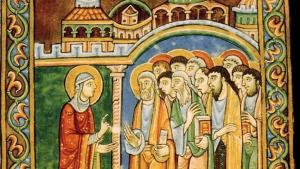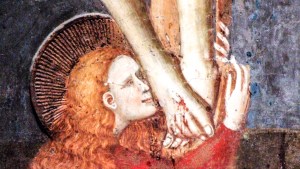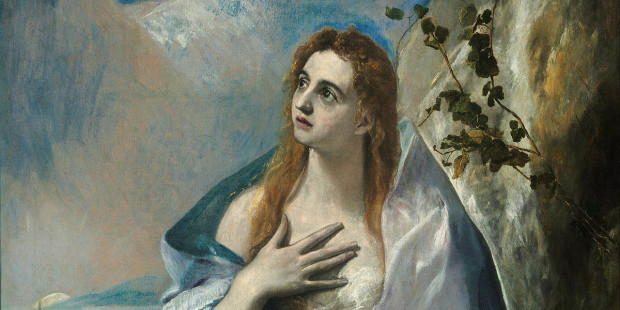The Gospels present Mary Magdalene as a disciple of Jesus, an eyewitness of His death on the cross, and the first witness of His resurrection.
In the four Gospels, she is mentioned 12 times, eleven of which are directly related to Jesus’ Passion and Resurrection.
Only Luke (8:2-3) includes the detail that “Mary, called Magdalene” was a woman whom Jesus had freed from seven demons. We don’t know anything more—nor can we say that she was a prostitute, as is commonly believed.
Having had the privilege of being the first to contemplate the Risen Lord, she was sent by Jesus Himself to proclaim the good news to the apostles.

Read more:
Mary Magdalene, “Apostle to the Apostles,” Given Equal Dignity in Feast
Since “apostle” means “sent,” it’s understandable that, for this reason, the Fathers of the Church, and John Paul II as well, called her the “apostle of the apostles.”
The affection felt for Mary Magdalene, as much in early Christianity as throughout the rest of the history of the Church, is reflected in the large number of churches dedicated to her.
Between history and legend
Her popular representation as a prostitute and repentant sinner wasn’t a plan conceived by the apostles to discredit her, as some esoteric and pseudo-historical novels would have us believe; there is no textual evidence to support such an affirmation.
The mistake of identifying her with a repentant sinner actually has a more recent origin, in the Middle Ages.
It started with an Easter homily by Pope Gregory the Great in the year 591, in which he juxtaposed the repentant sinner of Luke 7:37 with Mary of Bethany (Luke 10:38-42), and with Mary Magdalene, from whom Jesus had expelled seven demons (Luke 8:1), as if they were all the same woman.
Many people still identify Mary Magdalene as the repentant sinner who appears in the seventh chapter of the Gospel of Luke. She is also identified sometimes as the adulterous woman who appears in the Gospel of John (chapter 8), but we don’t even know that woman’s name.
From that moment on, the common misconception that Mary Magdalene was a prostitute, also identified with the repentant sinner who appears in Luke’s Gospel, started to appear in art, preaching, and the liturgy.
Nevertheless, this understanding was opposed decades ago by Catholic theologians and by recent popes. On the Magdalene’s liturgical feast day (July 22), the Gospel reading at Mass is the scene where she is outside Jesus’ tomb, not the text about the repentant sinner. This recognizes her importance as a disciple sent to bear witness to her faith in the Risen Christ.
Referring to the pope who made that erroneous interpretation, historian Katherine Ludwig Jansen writes, “It would be a grave error of historical interpretation to see it as a conspiracy or as a malicious act on his part. One must see Gregory in his context, which was a time characterized by intense disturbances: German invasions, a plague, famine … the Roman world was crumbling under his feet.” It was an epoch of great uncertainty, when the figure of Mary Magdalene was an icon of hope with whom believers who went from being “sinners to faithful disciples” could identify.
Gnostic and New Age versions
Thanks to many pseudo-historical novels and gnostic texts, people are once again proposing a version of the Gospel in which Jesus had a “special” relationship with Mary Magdalene, as if she had been his wife or lover.
But even the gnostic gospels, besides having no historical value regarding Christianity and having been composed much later than the canonical Gospels, do not speak of a special relationship except in a symbolic and mystical sense.
The Gnostics had a great disdain for women, portraying them as second-class human beings as compared to men. The only gospel that speaks of a special relationship between Jesus and Mary Magdalene is the gnostic gospel of Philip, but it does so to propose Gnostic doctrine through the person of Jesus.
Many incautious readers were seduced by the idea of finding a girlfriend or a wife for Jesus, but according to canonical sources, it’s clear that Jesus was celibate, and that the Magdalene held a special place as one of his disciples.
Mary Magdalene in the south of France?
It’s true that during the Middle Ages a strong devotion to Mary Magdalene arose in France, and legends about her appeared. Many churches were built in her honor, and in the 13th century, there was even talk of her tomb being located in Provence.
The fact is that, not only are there no traces of Mary Magdalene in France before the 9th century, but it seems all the legends are nothing but inventions.
During the Middle ages, a legend appeared describing the arrival of Lazarus and his sisters Martha and Mary in France; but that Mary isn’t the Magdalene, but Mary of Bethany.
Given the confusion that merged these women starting in the 6th century thanks to Pope Gregory’s homily, it’s not surprising that Mary Magdalene became included in this legend.
It’s also known that there are no traces of Christianity in those regions until the beginning of the 3rd century; consequently, it seems that neither Lazarus nor either Mary reached that place. The Saint Lazarus known in France is from the 3rd century, and isn’t the same one that appears in the Bible.
The entire legend of Mary Magdalene being in France is a medieval invention that then fed other legends. This is understandable in the context of the Middle Ages, when in the face of Muslim invasions, many regions invented claims to have relics of saints to obtain protection and prestige.
Similarly, throughout Europe, many unfounded stories became popular devotion over the centuries.
Mary Magdalene and the Church
Even if the Catholic Church doesn’t present Mary Magdalene as a repentant prostitute, it has been difficult to eradicate this medieval idea from the popular imagination. She is still portrayed that way in Christian movies and catechetical publications.
In 1969, Pope Paul VI removed from the liturgical calendar the appellative “penitent,” which had traditionally been applied to Mary Magdalene, and since then, the readings of the liturgy of the day ceased to be those referring to the penitent sinner and began to be the Gospel passages that properly refer to her.
John Paul II, in the letter Mulieris Dignitatem, refers to her as “the apostle of the apostles,” a title already used by the Fathers of the Church in the first centuries, and he describes her as one of those “women [who] proved stronger than the Apostles” at the moment of the crucifixion, remaining at Jesus’ side.
On June 10, 2016, the Holy See issued a decree elevating the memorial of St. Mary Magdalene to the level of a feast in the General Roman Calendar.

Read more:
Befriending Mary Magdalene and the witnesses of hope

